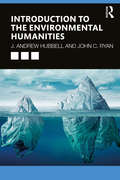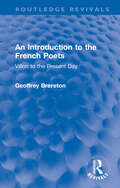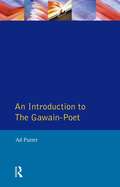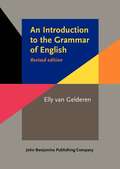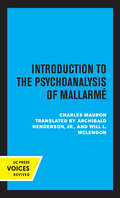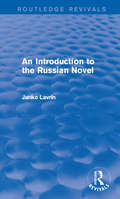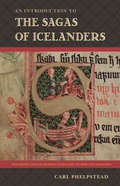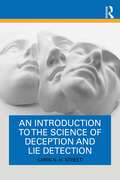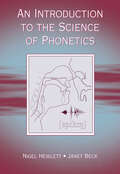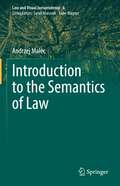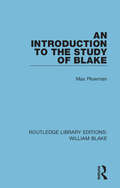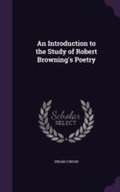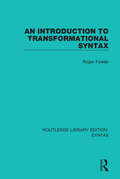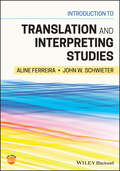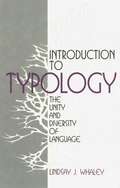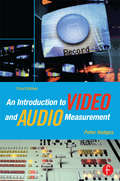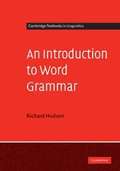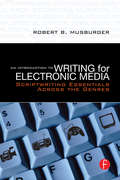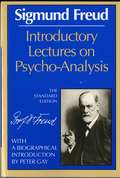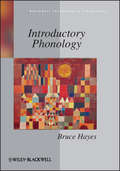- Table View
- List View
Introduction to the Environmental Humanities
by J. Andrew Hubbell John C. RyanIn an era of climate change, deforestation, melting ice caps, poisoned environments, and species loss, many people are turning to the power of the arts and humanities for sustainable solutions to global ecological problems. Introduction to the Environmental Humanities offers a practical and accessible guide to this dynamic and interdisciplinary field. This book provides an overview of the Environmental Humanities’ evolution from the activist movements of the early and mid-twentieth century to more recent debates over climate change, sustainability, energy policy, and habitat degradation in the Anthropocene era. The text introduces readers to seminal writings, artworks, campaigns, and movements while demystifying important terms such as the Anthropocene, environmental justice, nature, ecosystem, ecology, posthuman, and non-human. Emerging theoretical areas such as critical animal and plant studies, gender and queer studies, Indigenous studies, and energy studies are also presented. Organized by discipline, the book explores the role that the arts and humanities play in the future of the planet. Including case studies, discussion questions, annotated bibliographies, and links to online resources, this book offers a comprehensive and engaging overview of the Environmental Humanities for introductory readers. For more advanced readers, it serves as a foundation for future study, projects, or professional development.
An Introduction to the French Poets: Villon to the Present Day (Routledge Revivals)
by Geoffrey BreretonThe French poetry of some five centuries is here surveyed in a series of studies of the work and personality of individual poets from Villon to the present day. Each chapter is primarily concerned with establishing the ‘literary identity’ of the poet or poets with whom it deals: the work of each is outlined and related to the historical and biographical circumstances in which it was written; and its characteristics are then examined critically in terms relevant to the modern reader. Comparisons are made between different poets, and more general topics – such as the concepts of ‘classic’ and ‘baroque’ – are discussed. This book, first published in 1956, had become a standard introductory work for students of French poetry and general readers alike. For this revised edition, originally published in 1973, new chapters have been added on ‘irregular’ seventeenth-century poets and on various modern poets whose work now enables the Surrealist movement to be seen in clearer perspective. The bibliography has been revised extensively.
An Introduction to the Gawain Poet (New Perspectives on Medieval Literature: Authors and Traditions)
by John M BowersIn An Introduction to the Gawain Poet, John Bowers surveys an expanded selection of the works of Chaucer's anonymous contemporary, considering Sir Gawain and the Green Knight alongside the poet's lesser known but no less brilliant works.In addition to his succinct introductions and plot summaries, Bowers skillfully details the cultural, historical, political, and religious contexts for these works, synthesizing them with close reading of selected passages. Perhaps his most exciting contribution to the field is his choice to historicize the poet's life and works in the context of the royal culture of King Richard II, boldly contending that it was highly possible the Gawain Poet was a frequent visitor to Richard's court in London. The final chapter surveys the works influenced by, as well as the influences reflected in, the poet's work, from the Bible to The Lord of the Rings. The attention Bowers pays to the critical tradition that has developed around these texts over the past hundred years makes An Introduction to the Gawain Poet an ideal volume for both undergraduate students and scholars of the Gawain Poet. Bowers has marshaled his formidable skills to create a book impressive in its balanced combination of breadth and depth.
An Introduction to The Gawain-Poet (Longman Medieval and Renaissance Library)
by Ad PutterThe late 14th century produced a crop of brilliant writers: Chaucer, Langland and Gower. Their achievement was rivalled only by a series of four works generally agreed to have been written by a single northern author, known as the Gawain-Poet. This book introduces the reader to the Gawain-poet's four surviving works: Sir Gawain and the Green Knight, Patience, Pearl and Cleanness. The four poems are made accessible to the student by setting them in their relevant historical and cultural context and by developing some lines of critical argument. All studies are based on the author's own research and translations.
An Introduction to the Grammar of English
by Elly Van GelderenIt has been eight years since An Introduction to the Grammar of English was first published. The second edition is completely revised and greatly expanded, especially where texts, example sentences, exercises, and cartoons are concerned. It continues to provide a very lively and clearly written textbook. The book introduces basic concepts of grammar in a format which inspires the reader to use linguistic arguments. The style of the book is engaging and examples from poetry, jokes, and puns illustrate grammatical concepts. The focus is on syntactic analysis and evidence. However, special topic sections contribute sociolinguistic and historical reasons behind prescriptive rules such as the bans on split infinitives, dangling participles, and preposition stranding. The book is written for undergraduate students and structured for a semester-long course. It provides exercises, keys to those exercises, and sample exams. It also includes a comprehensive glossary.
Introduction to the Nonprofit Sector: A Practical Approach for the Twenty-first Century
by Gary M. GrobmanThis is an introductory text on the nonprofit sector and nonprofit organizations. It provides an overview of the history, theory, and scope of the nonprofit sector. It discusses issues facing nonprofits, such as legal and regulatory issues, ethics, quality, fiscal, and liability issues. It also provides practical guidelines for writing mission and vision statements, strategic planning, hiring, firing, lobbying, communicating, using the Internet, and other functions of nonprofit organizations. Each chapter includes a synopsis at the beginning, as well as discussion questions, activities, and bibliographic references at the end. An index is included.
An Introduction to the Philosophy of Language
by Michael MorrisIn this textbook, Michael Morris offers a critical introduction to the central issues of the philosophy of language. Each chapter focusses on one or two texts which have had a seminal influence on work in the subject, and uses these as a way of approaching both the central topics and the various traditions of dealing with them. Texts include classic writings by Frege, Russell, Kripke, Quine, Davidson, Austin, Grice and Wittgenstein. Theoretical jargon is kept to a minimum and is fully explained whenever it is introduced. The range of topics covered includes sense and reference, definite descriptions, proper names, natural-kind terms, de re and de dicto necessity, propositional attitudes, truth-theoretical approaches to meaning, radical interpretation, indeterminacy of translation, speech acts, intentional theories of meaning, and scepticism about meaning. The book will be invaluable to students and to all readers who are interested in the nature of linguistic meaning.
Introduction to the Psychoanalysis of Mallarme (Perspectives in Criticism #10)
by Charles MauronThis title is part of UC Press's Voices Revived program, which commemorates University of California Press’s mission to seek out and cultivate the brightest minds and give them voice, reach, and impact. Drawing on a backlist dating to 1893, Voices Revived makes high-quality, peer-reviewed scholarship accessible once again using print-on-demand technology. This title was originally published in 1963.
An Introduction to the Psychology of Language (Psychology Library Editions: Psycholinguistics)
by Peter HerriotOriginally published in 1970, this was Peter Herriot’s first book. In this objective, critical evaluation of a rapidly expanding field, Professor Herriot examines language as skilled behaviour, generative linguistics and psychology, behaviourist approaches to meaning, language acquisition and impairment, and language and thought. He stresses throughout the necessity for empirical research and for experimental verification of hypotheses; he also feels that language behaviour should be analysed in a comprehensive form, placing emphasis not only on structural aspects but also on the importance of meaning and context to any account of language. Today it can be read and enjoyed in its historical context.
An Introduction to the Russian Novel (Routledge Revivals)
by Janko LavrinIn this book, first published in 1943, Janko Lavrin provides an overview of the development of the Russian novel by placing the great Russian novelists – Tolstoy, Dostoevsky, Turgenev, Gorky, Gogol – in relation to their native literature and their social, political and cultural backgrounds. An Introduction to the Russian Novel will appeal particularly to students of Russian literature and culture as well as those interested in the development of the novel in general.
An Introduction to the Sagas of Icelanders (New Perspectives on Medieval Literature: Authors and Traditions)
by Carl PhelpsteadCombining an accessible approach with innovative scholarship, An Introduction to the Sagas of Icelanders provides up-to-date perspectives on a unique medieval literary genre that has fascinated the English-speaking world for more than two centuries. Carl Phelpstead draws on historical context, contemporary theory, and close reading to deepen our understanding of Icelandic saga narratives about the island’s early history. Phelpstead explores the origins and cultural setting of the genre, demonstrating the rich variety of oral and written source traditions that writers drew on to produce the sagas. He provides fresh, theoretically informed discussions of major themes such as national identity, gender and sexuality, and nature and the supernatural, relating the Old Norse-Icelandic texts to questions addressed by postcolonial studies, feminist and queer theory, and ecocriticism. He then presents readings of select individual sagas, pointing out how the genre’s various source traditions and thematic concerns interact. Including an overview of the history of English translations that shows how they have been stimulated and shaped by ideas about identity, and featuring a glossary of critical terms, this book is an essential resource for students of the literary form. A volume in the series New Perspectives on Medieval Literature: Authors and Traditions, edited by R. Barton Palmer and Tison Pugh
An Introduction to the Science of Deception and Lie Detection
by Chris N. StreetThis accessible book provides a foundational understanding of the science of deception and lie detection. Focusing on core issues for the field, it discusses classic and current psychological research into lying as well as theoretical approaches to understanding human lie detection. This book explores engaging questions around how people lie, how people make decisions about believing others, and how we can detect deception. Each chapter is clearly structured to support students of all levels by summarising content, presenting key research, and systematically evaluating findings. Chapters explore topics including some of the most promising current lie detection techniques, how and why people lie, how lying develops in children, and whether unconscious thinking can boost lie detection accuracy. Providing an overview of key issues in deception, this book will be of great interest to students and lecturers in the field of deception and lie detection, as well as anyone generally interested in this fascinating field of research.
An Introduction to the Science of Phonetics
by Nigel Hewlett Janet Mackenzie BeckThe book is designed as an introduction to the scientific study of speech. No prior knowledge of phonetics is assumed. As far as mathematical knowlege is concerned, all that is assumed is a knowledge of simple arithmetic and as far as possible concepts are dealt with on an intuitive rather than mathematical level. The anatomical material is all fully explained and illustrated. The book is arranged in four parts. Part 1, Basic Principles, provides an introduction to established phonetic theory and to the principles of phonetic analysis and description, including phonetic transcription. Part 2, Acoustic Phonetics, considers the physical nature of speech sounds as they pass through the air between speaker and hearer. It includes sections on temporal measurement, fundamental frequency, spectra and spectrograms. Part 3, Auditory Phonetics, covers the anatomy of the ear and the perception of loudness, pitch and quality. The final part, Part 4, covers the articulatory production of speech, and shows how experimental techniques and tools can enhance our understanding of the complexities of speech production. Though the audience for this book is mainly students and professors in the Speech Sciences, it will also be valuable to any students studying hearing science and acoustics. The book is well supported with figures, tables, and practice boxes with experiments.
Introduction to the Semantics of Law (Law and Visual Jurisprudence #6)
by Andrzej MalecThis book offers an introduction to the language of law from the perspective of logical semantics. As a logical tool, Boguslaw Wolniewicz’s formal ontology of situations is adapted. The central issue addressed is the meaning of normative statements, primarily legal norms. The main outcome of the book consists in explications of several legal notions (including legal events, legal acts and legal rules) in terms of the formal ontology of situations. In addition, the book concludes that legal norms are sentences in a logical sense, so some are true, while others are false, and that their logical value does not depend on whether or not they were adopted in the law-making process. Lastly, the book contends that there are semantic relations between orders that are similar to entailment, contradiction, opposition, and sub-opposition, despite the fact that orders are not sentences in a logical sense, i.e., they are neither true nor false.The book also presents some original Wittgenstein-style deontic logics built on the first order logic. The formal results are applied to selected problems in the theory of law, including the problem of the possibility of algorithmic application of legal norms.
An Introduction to the Study of Blake (Routledge Library Editions: William Blake #5)
by Max PlowmanFirst published in 1927 (this edition in 1967), this book is about Blake, his symbols, and their meanings. As Ward says in his forward, the volume goes beyond Blake, becoming universal and timeless, and is about Religion. Plowman’s book presents itself, not as a critical text, but an interpretative one, and the study therefore illuminates the work of the author, as well as that of William Blake.
An Introduction To The Study Of Literature
by William Henry HudsonThe aim of this book is to set forth, in the simplest possible way, some of the questions to be considered and the principles to be kept in view in the systematic study of literature.
An Introduction to Transformational Syntax (Routledge Library Editions: Syntax #9)
by Roger FowlerTransformational syntax is an analytic technique of grammatical description which has exciting psychological and philosophical ramifications inspiring creative research into the conceptual powers and behaviour of man. In this book, first published in 1971, the author suggests that the techniques of the classical period (1964-66) of transformational syntax provide the securest foundation for syntactic analysis, and are indispensable if students are to understand recent changes to the analytical technique. This title will be of interest to students of language and linguistics.
Introduction to Translation and Interpreting Studies
by Aline Ferreira John W. SchwieterA unique and balanced combination of translation and interpreting studies, edited and written by leading voices in the fields In Introduction to Translation and Interpreting Studies, accomplished scholars Aline Ferreira and John W. Schwieter have brought together a detailed and comprehensive introductory-level textbook covering the essential aspects of translation and interpreting studies. Through chapters authored by leading voices in the field, this book covers topics of theoretical and conceptual relevance—such as the history of the development of the field and methods for understanding gender, society, and culture as aspects of the role of the interpreter—as well as critical topics in the application of theory to real world practice. Beginning with an authoritative treatment of the theoretical developments that have defined the field since the early 1970s, this textbook first describes the influential work of such figures as Jakobson, Holmes, and Toury, thus ensuring students develop a thorough understanding of the history and theoretical underpinnings of the fields of translation and interpreting studies. The text then begins to introduce grounded discussions of interpreting in specialized fields such as legal and healthcare interpreting and sign language translation. Learning is reinforced throughout the text through pedagogical features including reflection questions, highlighted key words, further readings, and chapter objectives. Instructors will also have access to companion website with PowerPoint slides and multiple-choice questions to support classroom application. Truly a unique work in translation and interpreting studies, this essential new textbook offers: A thorough introduction to the fields of translation and interpreting with discussion of applications to interdisciplinary topics Explorations of translation machines and technology, including their history and recent trends Practical discussions of culture, gender, and society in the context of translation and interpreting studies, as well as training and pedagogical issues in translation and interpreting A concise examination of translation process research and methods, including the mental processes and actions that people take while translating Complementary web materials including PowerPoint slides and practice questionsIdeal for advanced undergraduate and graduate students in programs in such as linguistics, language studies, and communications, or for those who plan to work in translation and/or interpreting, Introduction to Translation and Interpreting Studies will earn a place in the libraries of anyone interested in a reader-friendly translation and interpreting resource.
Introduction to Typology: The Unity and Diversity of Language
by Dr Lindsay J. WhaleyIdeal in introductory courses dealing with grammatical structure and linguistic analysis, Introduction to Typology overviews the major grammatical categories and constructions in the world's languages. Framed in a typological perspective, the constant concern of this primary text is to underscore the similarities and differences which underlie the vast array of human languages.
An Introduction to Video and Audio Measurement
by Peter HodgesWhat do we measure and why? Peter Hodges explains the answer to this question in approachable language and with clear illustrations. Newcomers to the video industry, as well as those already established, will find this uniquely readable guide to the basics of a complex subject. Building on the success of the two previous editions of this popular title and covering both analog and digital video, the third edition includes new sections on audio measurement, high definition video, and innovative techniques of test and measurement.
An Introduction to Word Grammar
by Richard HudsonWord grammar is a theory of language structure and is based on the assumption that language, and indeed the whole of knowledge, is a network, and that virtually all of knowledge is learned. It combines the psychological insights of cognitive linguistics with the rigour of more formal theories. This textbook spans a broad range of topics from prototypes, activation and default inheritance to the details of syntactic, morphological and semantic structure. It introduces elementary ideas from cognitive science and uses them to explain the structure of language including a survey of English grammar.
An Introduction to Writing for Electronic Media: Scriptwriting Essentials Across the Genres
by Robert B. MusburgerLearn what it takes to write for commercials, news, documentaries, corporate, educational, animation, games, the internet, and dramatic film & video productions * Outlines the key skills needed for a successful media writing career The demand for quality and knowledgeable multi-platform writing is always in high demand. An Introduction to Writing for Electronic Media presents a survey of the many types of electronic media you can write for, and explains how to do it. Musburger focuses on the skills you need to write for animation versus radio or television news versus corporate training. Sample scripts help you learn by example while modeling your own scripts. Production files illustrate the integral role writers' play in the production process, and individual movie frames allow you compare these to the real scripts. Armed with the skills developed in this book, a media writer can apply for a variety of positions in newsrooms, advertising firms, motion pictures or animation studios, as well as local and national cable operations. Robert B. Musburger, Ph.D., is Professor Emeritus and former Director of the School of Communication, University of Houston, USA. He has worked for 20 years in professional broadcasting, serving as camera operator, director, producer, and writer. Musburger has received numerous awards for his video work and teaching and he continues to work in electronic media with his Seattle, WA,. consulting firm, Musburger Media Services.
Introductory Lectures On Psycho-Analysis
by Sigmund Freud Translated edited by James StracheyFreud approved the overall editorial plan, specific renderings of key words and phrases, and the addition of valuable notes, from bibliographical and explanatory. <P><P>Many of the translations were done by Strachey himself; the rest were prepared under his supervision. The result was to place the Standard Edition in a position of unquestioned supremacy over all other existing versions.
Introductory Phonology
by Bruce HayesAccessible, succinct, and including numerous student-friendly features, this introductory textbook offers an exceptional foundation to the field for those who are coming to it for the first time.Provides an ideal first course book in phonology, written by a renowned phonologist Developed and tested in the classroom through years of experience and use Emphasizes analysis of phonological data, placing this in its scientific context, and explains the relevant methodology Guides students through the larger questions of what phonological patterns reveal about language Includes numerous course-friendly features, including multi-part exercises and annotated suggestions for further reading at the end of each chapter
